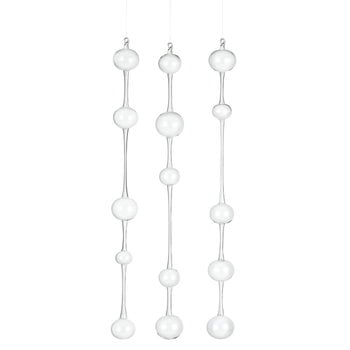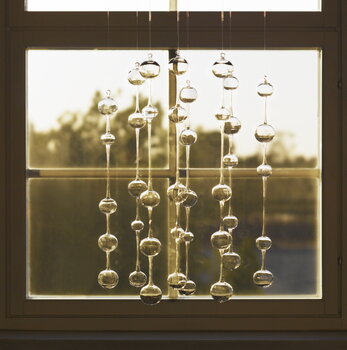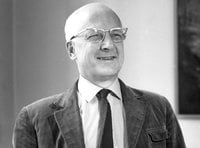Morning in Athens is a sculpture made of glass pendants. For this sculpture, Kaj Franck was inspired by the beauty of Greece. When moved by the wind, the fragile orbs issue a soft, metallic sound reminiscent of the church bells of Athens on a Sunday morning. Morning in Athens was in production during the years 1954-1975 and 1992-1994 at the Nuutajärvi factory, the oldest glass factory in Finland, and has now being reintroduced. Made from hand-blown glass, Morning in Athens is available in three slightly different models and this set includes all three.
Morning in Athens, set of 3
Iittala
Description
Morning in Athens is a sculpture made of glass pendants. For this sculpture, Kaj Franck was inspired by the beauty of Greece. When moved by the wind, the fragile orbs issue a soft, metallic sound reminiscent of the church bells of Athens on a Sunday morning. Morning in Athens was in production during the years 1954-1975 and 1992-1994 at the Nuutajärvi factory, the oldest glass factory in Finland, and has now being reintroduced. Made from hand-blown glass, Morning in Athens is available in three slightly different models and this set includes all three.
Product details (4)
- Colour
- Clear
- Size
- Length 630 mm
- Material
- Hand-blown glass
- Notes
- Hanging thread includes the package.
- Product ID
Designer
Finnish ceramic and glass designer Kaj Franck (1911-1989) realized a powerful truth in his distinguished career: simple is beautiful. Despite the world moving at an ever-fastening pace, from one decade to another, that simple truth remains. Franck’s inspiration and principles began a tradition in Finnish design, which is still alive and strong today. His best-known works are Iittala Teema and Kartio series, and his heritage is a part of every Finnish home.
"I want to make use of objects that are so obvious that they are not noticeable”, Kaj Franck defined his own work. His designs catered to basic human needs while serving them tools with properties of everyday objects. Franck was also interested in low-cost mass production and shunned materialism, throwaway culture and showing off. Franck’s world consisted of the basic mathematical shapes and simple forms, decorated only with strong colours.
The starting point of Franck's work was practicality combined with beauty. Although it seems self-evident today, in his own time his thoughts were radical. Franck separated styles and fashion trends from tradition and gave it a whole new meaning. In the period of 1952-53, Franck showed that dinnerware does not need to be overly complex with the release of the Kilta series as strong statement – it was a novel idea that everyone was able to do table settings according to their own needs.
Franck began his designs by focusing on the idea or underlying concept, not the shape. This emphasis on the idea aspect of design was also carried to his work as a teacher and later as an artistic director at the University of Art and Design in Helsinki. Franck was also one of the first advocates of recycling, and he has often been called the "conscience of Finnish design”. Franck won many awards in his distinguished career and became internationally famous. Today, the Kaj Franck Award is Finland's most prestigious design recognition.
View all productsReviews (3)
4.67
Based on 3 reviews
-
G
Greg G
United States
A beautiful and minimilist touch to my living room
244 days ago
-
A
Anonymous
Sakai, Japan
The product is beautiful! When the product was shipped, we found out that one of the sets was broken, which made us sad. But we really appreciate that Finnish design shop quickly replied our message and solved the problem.
16 days ago
-
S
Sari V
95 days ago
Sustainability
The Product Sustainability Framework, our criteria of sustainable design, helps you find the most sustainable products in our selection. Read below which sustainability criteria this product has met.
Working conditions & labour 8/9
-
Equal opportunities for all employees
-
Commitment to UN Global Compact, fair compensation for all employees
-
Corporate responsibility requirements defined and communicated for suppliers
-
Systematic work for improved inclusion and well-being in the workplace
-
Transparent supply chain
-
Suppliers' compliance to a code of conduct ensured
-
Compliance to the UN Guiding Principles on Business and Human Rights ensured in the supply chain
-
Support for community involvement in the supply chain
-
Direct suppliers audited and certified
Eco-friendly production 7/9
-
Fair and resource-wise water-use in production
-
No incineration or landfilling of returned items
-
No use of endangered species as materials
-
No direct environmental emissions or waste (excl. GHGs) from production
-
The sustainability of direct suppliers' production is addressed and monitored
-
Material-efficient and ecological packaging
-
Positive impact on nature’s well-being through operations that regenerate natural ecosystems
-
Production and material sourcing that respect biodiversity, animal rights, and natural ecosystems
-
No potentially harmful chemicals used in own production
Climate impact 5/8
-
Company's direct greenhouse gas emissions identified and commitment to reduction
-
Product's carbon impact identified and commitment to reduction
-
Guidance on energy- and eco-efficient use of the product
-
Contribution to climate initiatives beyond the brand’s direct operations
-
Low-carbon or compensated transportation
-
Carbon footprint of the product calculated and goals set to reduce it
-
100 % renewable energy in own production and operations
-
Carbon neutral or carbon negative product
Sustainable materials 4/6
-
Sustainable and long-lasting material choices
-
No harmful or hazardous substances
-
Responsible raw material sourcing and production
-
Ecological materials: natural, biodegradable, recyclable or recycled contents
-
Materials suited for circularity: monomaterials, recyclable finishings, renewable or recycled contents etc.
-
Outstanding materials in terms of innovativeness, responsibility, sustainability and circularity: local production or sourcing, 100 % recycled content, C2C-certification etc.
Circular design 3/5
-
High aesthetic quality promoting long-term use of the product
-
Technically durable product design and material choices
-
Design for enduring life-long quality
-
Design and support for product maintenance, repair and upgradability
-
Innovative circular design solutions: circular service system, resale platform, remanufacturing, collection of used products, etc.






